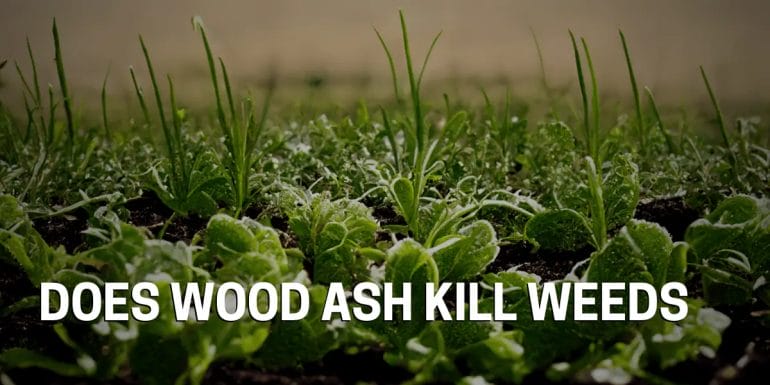Looking for an effective and natural way to control weeds in your garden? Look no further than wood ash! Wood ash, a byproduct of burning wood, can be a powerful and eco-friendly weed killer. Its high alkalinity levels disrupt the pH balance of the soil, making it inhospitable for weed growth.
When applied correctly, wood ash can effectively kill existing weeds and prevent new ones from sprouting. Simply sprinkle a thin layer of wood ash over the affected areas, making sure to avoid desirable plants. Be cautious, though, as excessive use of wood ash can harm certain plants that prefer acidic soil conditions.

Not only does wood ash have weed-killing properties, but it also acts as a natural fertilizer, providing essential nutrients like potassium and calcium to your plants. This dual benefit makes it an excellent choice for those seeking a cost-effective and organic solution for weed control in their garden.
Before applying wood ash, it’s recommended to test the pH levels of your soil to ensure it doesn’t become too alkaline. Additionally, always wear protective gloves and goggles when handling wood ash to avoid any potential irritations.
So, if you’re looking for an eco-friendly way to eliminate weeds in your garden while providing essential nutrients to your plants, give wood ash a try!

Using Wood Ash to Naturally Control Weeds in Your Garden
One common problem that gardeners face is weed control. Weeds can quickly take over a garden, stealing nutrients and sunlight from desirable plants. While there are many chemical herbicides available on the market, they can be harmful to the environment and may not be suitable for organic gardening. However, there is a natural solution that can help control weeds in your garden – wood ash.
What is Wood Ash?
Wood ash is the powdery residue left behind after burning wood. It is rich in various minerals and nutrients, including potassium, calcium, and magnesium. These elements are essential for plant growth and can help balance the pH levels in the soil. Wood ash also contains a high concentration of alkaline compounds, which makes it an effective natural weed control method.
How Does Wood Ash Control Weeds?
When wood ash is applied to the soil, it alters the pH level, making it more alkaline. Most weeds prefer acidic soil conditions, so the increased alkalinity prevents their growth and development. Additionally, the high alkaline content in wood ash disrupts the cell structures of weed plants, causing them to dry out and die.
How to Use Wood Ash in Your Garden
Before using wood ash in your garden, it is crucial to determine the soil’s pH level. You can purchase a soil testing kit from a garden center or send a soil sample to a laboratory for analysis. If the pH level is already alkaline, it is not advisable to add more wood ash, as it can lead to nutrient imbalances. However, if the soil is acidic, wood ash can be a valuable tool for weed control.
To use wood ash effectively, follow these steps:
- Collect the wood ash from a clean and safe source, such as your fireplace or woodstove.
- Make sure the ash has cooled down completely before handling it.
- Wear protective gloves and a dust mask to avoid any irritation from the ash.
- Apply a thin layer of wood ash to the areas where weeds are prevalent, avoiding contact with desirable plants.
- Gently work the ash into the soil using a rake or garden fork.
- Water the treated area lightly to help the ash settle into the soil.
It is important to note that wood ash should be used sparingly. Excessive application can harm plants and disrupt the overall balance of nutrients in the soil. It is recommended to use wood ash as a preventive measure before weed seeds sprout or as a spot treatment for existing weeds.
Benefits of Using Wood Ash
Aside from its weed control properties, wood ash offers several benefits for your garden:
- Acts as a natural fertilizer, providing essential minerals for plant growth.
- Improves soil structure and drainage.
- Helps neutralize acidic soils and reduce the need for additional amendments.
- Contains trace elements that promote healthy root development.
- Can be used as compost additive or incorporated into a compost pile.
In Summary
Wood ash is a natural and effective method for controlling weeds in your garden. It alters the pH level of the soil and disrupts weed growth, making it a safe and environmentally friendly alternative to chemical herbicides. Remember to use wood ash sparingly and test your soil’s pH level before application. With proper usage, wood ash can help maintain a weed-free and healthy garden.

Benefits and Drawbacks of Using Wood Ash to Kill Weeds
When it comes to weed control, there are many methods and solutions available. One natural and cost-effective option is the use of wood ash. Wood ash is the residue left behind after burning wood, and it contains several compounds that can be beneficial for killing weeds. However, it’s essential to understand both the benefits and drawbacks of using wood ash before incorporating it into your weed control routine.
Benefits of Using Wood Ash to Kill Weeds
1. Provides Nutrients: Wood ash contains essential nutrients that can benefit your garden. It is rich in potassium, which is an essential nutrient for plant growth. The potassium in wood ash can help improve the overall health and vigor of your plants.
2. Alters Soil pH: Wood ash has alkaline properties, meaning it can raise the pH of acidic soil. Many weeds thrive in acidic soil conditions, and by using wood ash, you can create an environment that is less favorable for weed growth.
3. Acts as a Natural Herbicide: Wood ash contains salts, such as calcium carbonate, that have herbicidal properties. When applied to weeds, these salts can dehydrate and damage the plant cells, eventually leading to their death.
4. Environmentally Friendly: Unlike chemical herbicides, wood ash is a natural and environmentally friendly option for weed control. It does not harm beneficial insects or contaminate groundwater, making it a safer choice for both your garden and the ecosystem.
Drawbacks of Using Wood Ash to Kill Weeds
1. pH Imbalance: While wood ash can be beneficial for acidic soil, it can cause an imbalance if your soil is already alkaline or neutral. It’s important to test your soil’s pH before applying wood ash and ensure that the pH levels remain within the optimal range for your plants.
2. Limited Weed Control: Wood ash primarily works as a desiccant on contact, meaning it only affects the parts of the weed it comes into direct contact with. It may not be as effective in controlling deep-rooted perennial weeds or weeds with extensive root systems.
3. Safety Precautions: When handling wood ash, it’s crucial to take safety precautions. Wood ash can be caustic and abrasive, so it’s essential to wear protective gloves and eyewear to prevent skin and eye irritation. Additionally, avoid inhaling wood ash dust, as it can irritate your respiratory system.
4. Timing and Application: To achieve effective weed control, timing and application are crucial. Wood ash should be applied when the weeds are actively growing, and it’s important to ensure proper coverage of the weed foliage for maximum contact with the herbicidal salts.
Summary
In summary, using wood ash to kill weeds can be a natural and cost-effective solution. It provides essential nutrients, alters soil pH, acts as a natural herbicide, and is environmentally friendly. However, it’s important to consider the drawbacks, such as potential pH imbalance, limited weed control, safety precautions, and the need for proper timing and application. By understanding the benefits and drawbacks, you can make an informed decision about incorporating wood ash into your weed control strategy.

Step-by-Step Guide: How to Apply Wood Ash to Eliminate Weeds
If you’re looking for a natural and effective way to eliminate weeds in your garden or backyard, wood ash can be a great solution. Wood ash is rich in nutrients and minerals that can help suppress weed growth while providing benefits to your soil. In this section, we will provide you with a step-by-step guide on how to apply wood ash to eliminate weeds.
Step 1: Collect and Prepare the Wood Ash
The first step in applying wood ash to eliminate weeds is to collect the wood ash from your fireplace, wood-burning stove, or bonfire. Make sure to let the ashes cool down completely before handling them. You can use a metal container or bucket to collect the ashes.
Once you have collected the wood ash, it’s essential to break up any clumps or chunks to achieve a fine, powdery consistency. This can be done by using a garden trowel or a small handheld shovel.
Step 2: Identify Problematic Weed Areas
Next, you need to identify the areas in your garden or backyard that are heavily infested with weeds. These are the areas where you will focus your wood ash application.
Take some time to inspect your garden and locate the areas where weeds are the most problematic. This step will help you prioritize and concentrate your efforts on the areas that need the most attention.
Step 3: Apply Wood Ash to Weed-Infested Areas
Once you have identified the problematic weed areas, it’s time to apply the wood ash. Start by sprinkling a thin layer of wood ash directly onto the weeds and the soil surrounding them.
You can use your hands or a garden scoop to distribute the wood ash evenly. Be careful not to apply too much ash, as it can be harmful to certain plants and soil pH levels. A thin layer is sufficient to suppress weed growth without causing any negative effects.
Step 4: Water the Treated Areas
After applying the wood ash, it’s crucial to water the treated areas thoroughly. This will help the ashes to penetrate the soil and activate their weed-suppressing properties.
Make sure to water the areas evenly, ensuring that the wood ash is absorbed into the soil. Adequate watering will also prevent the ash from being blown away by the wind or washed away by rain.
Step 5: Monitor and Repeat as Needed
Once you have applied the wood ash and watered the treated areas, it’s essential to monitor the progress and repeat the process as needed. Some weeds may require multiple applications to be effectively controlled.
Regularly inspect the treated areas and remove any persistent or new weeds that may emerge. If necessary, reapply a thin layer of wood ash and repeat the watering process to maintain weed suppression.
Step 6: Dispose of Unused Ash Properly
Finally, it’s important to dispose of any unused wood ash properly. Avoid dumping wood ash in large quantities in one area, as it can disrupt the soil’s pH balance. Instead, spread it out in thin layers across different parts of your garden.
Alternatively, you can compost the wood ash along with other organic matter to create nutrient-rich compost for your plants. Just make sure to follow proper composting guidelines and avoid adding excessive amounts of wood ash.
In summary, applying wood ash to eliminate weeds can be an effective and eco-friendly approach. By following this step-by-step guide, you can take control of weed growth in your garden while nourishing your soil with valuable nutrients. Remember to always handle wood ash with care and follow the recommended application techniques for optimal results.
Common Mistakes to Avoid When Using Wood Ash as a Weed Killer
Using wood ash as a natural weed killer can be an effective and eco-friendly solution for your garden. However, there are some common mistakes that people make when using wood ash, which can affect its effectiveness. In this section, we will discuss the common mistakes to avoid when using wood ash as a weed killer and how to use it properly.
1. Using Freshly Burned Wood Ash
One of the common mistakes is using freshly burned wood ash. When wood ash is fresh, it retains high amounts of alkalinity, which can harm the plants and surrounding soil. It is important to allow the wood ash to cool down completely before using it as a weed killer. This will help to reduce its alkalinity and make it safer for your garden.
2. Applying Too Much Wood Ash
Another mistake is applying too much wood ash to the weeds. While wood ash can be effective in controlling weeds, excessive application can have negative consequences. Applying too much ash can increase the soil’s pH level significantly, making it unfavorable for the growth of other plants. It is recommended to use wood ash sparingly and only apply a thin layer to the weeds.
3. Using Wood Ash in Windy Conditions
Using wood ash as a weed killer on a windy day can lead to unintended consequences. The wind can easily blow the ash away from the targeted weeds, spreading it to other areas of your garden. This can potentially harm desirable plants or contaminate the surrounding environment. It is best to apply wood ash on a calm day to ensure that it stays where it is intended.
4. Ignoring Safety Precautions
When using wood ash as a weed killer, it is important to take proper safety precautions. Wood ash contains fine particles that can irritate the eyes, skin, and respiratory system. It is recommended to wear gloves, protective eyewear, and a mask while handling and applying wood ash. Additionally, wash your hands thoroughly after using wood ash to prevent any potential irritation or harm.
5. Applying Wood Ash to Acid-Loving Plants
Wood ash is alkaline in nature, which means it can raise the pH level of the soil. Therefore, it is not suitable for acid-loving plants such as rhododendrons, azaleas, and blueberries. Applying wood ash to these plants can disrupt their nutrient uptake and affect their overall health. It is essential to know the pH requirements of your plants before using wood ash as a weed killer.
In summary, when using wood ash as a weed killer, it is important to avoid the common mistakes mentioned above. Allow the ash to cool down completely before applying it, use it sparingly, avoid windy conditions, take safety precautions, and be cautious when using it around acid-loving plants. By using wood ash properly, you can effectively control weeds in your garden while promoting a healthy and thriving environment for your plants.
FAQs
Does wood ash kill weeds?
Yes, wood ash can be an effective natural weed killer. The high alkaline content of wood ash helps to raise the pH levels in the soil, making it less favorable for weeds to grow. Sprinkling wood ash around the base of weeds or directly on the soil can help to suppress weed growth.
Conclusion
In conclusion, wood ash can be an effective natural solution for weed control in your garden. Its high alkaline content helps to disrupt the pH balance of the soil, making it less favorable for weed growth. Additionally, wood ash contains essential nutrients that can nourish your plants and promote healthy growth.
However, it’s important to use wood ash in moderation, as excessive application can harm certain plants and disrupt the soil’s nutrient balance. It’s also crucial to avoid using wood ash near acid-loving plants, as it can further increase the soil’s alkalinity. Prior to using wood ash as a weed killer, it’s advisable to conduct a soil test and consult with a gardening expert for proper usage and dosage recommendations.